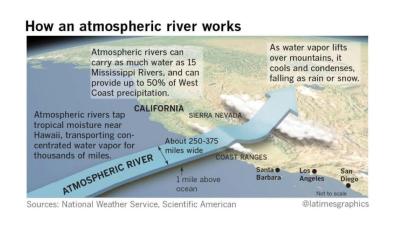Science Source
Changes in Winter Atmospheric Rivers along the North American West Coast in CMIP5 Climate Models
- States that global climate models have sufficient resolution to simulate synoptic features associated with atmospheric river (AR) events, such as high values of vertically integrated water vapor transport (IVT) approaching the coast
- Uses 10 simulations from phase 5 of the Coupled Model Intercomparison Project (CMIP5) to identify changes in ARs impacting the west coast of North America between historical (1970–99) and end-of-century (2070–99) runs, using representative concentration pathway (RCP) 8.5
- Identifies the most extreme ARs in both time periods by the 99th percentile of IVT days along a north–south transect offshore of the coast
- Finds that integrated water vapor (IWV) and IVT are predicted to increase, while lower-tropospheric winds change little
- Finds that winter mean precipitation along the west coast increases by 11%–18% [from 4% to 6% (°C)−1], while precipitation on extreme IVT days increases by 15%–39% [from 5% to 19% (°C)−1]
- Finds that the frequency of IVT days above the historical 99th percentile threshold increases as much as 290% by the end of this century
Related Content
Headline

Feb 14, 2019 | The Weather Channel
California Rain Triggers Evacuations, Mudslides; Woman Rescued from Sausalito Home
Headline

Feb 14, 2019 | Reuters
Mudslide risk from California storm forces hundreds to evacuate
Headline

Feb 13, 2019 | San Francisco Chronicle
Heavy storms shuts down SFO flights, floods roadways across region
Headline

Feb 13, 2019 | LA Times
As atmospheric rivers pound California, here comes the season’s ‘biggest storm’


